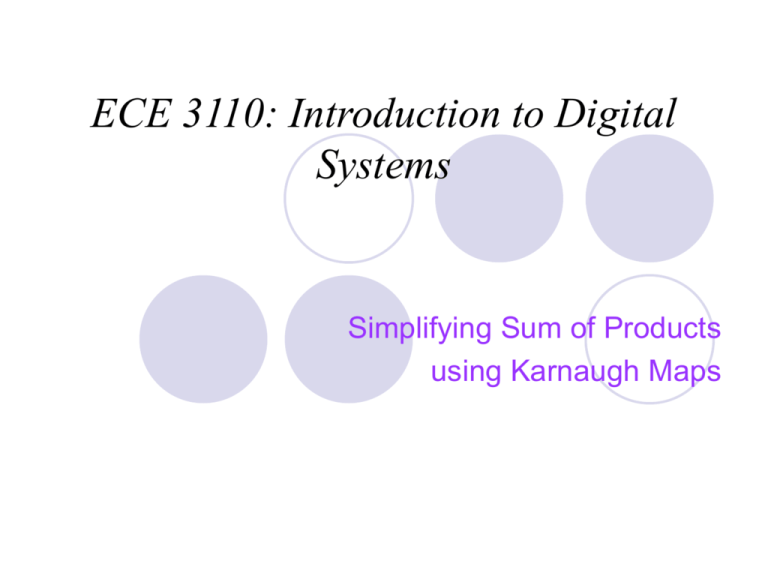Simplifying SOP (Contd.)
advertisement

ECE 3110: Introduction to Digital Systems Simplifying Sum of Products using Karnaugh Maps Previous… Simplifying SOP: Draw K-map Find prime implicants Find distinguished 1-cell Determine essential prime implicants if available Select all essential prime implicants and the minimal set of the remaining prime implicants that cover the remaining 1’s. 2 Example 2 - Combining (0,2) Product term : X’Z’ - Combining (2,3) Product term : X’Y - Combining (3,7) Product term :YZ XY X 00 Z 0 1 0 1 1 0 01 2 3 1 1 11 6 7 0 1 10 4 5 0 Z 0 X’Z’, X’Y, and YZ are prime implicants Y X’Z’, YZ are essential prime implicants X’Y is non-essential prime implicant (redundant) because all its minterms are covered in the other essential prime implicants F= X’Z’+X’Y+YZ (complete sum) OR: F = X’Z’+YZ ( the minimal sum of F ) 3 Example 3 The prime implicants : - Cells(0,1,2,3) : W’X’ - Cells(0,1,4,5) : W’Y’ - Cells(1,3,5,7) : W’Z - Cells(7,15) : XYZ - Cells(14,15) : WXY W WX 00 YZ 00 01 0 1 3 1 1 01 4 5 7 11 1 11 12 0 13 0 15 The essential prime implicants: 1 1 1 Y - W’X’ 2 1 6 14 10 1 - W’Y’ 0 1 - WXY Cell 7 is not covered by any of the X essential prime implicants. Its covered by two non-essential prime implicant. We choose the one with the less number of variables which is W’Z F= W’X’+W’Y’+WXY+W’Z 11 10 8 9 11 0 0 Z 0 10 0 4 eclipse Given two prime implicants P and Q in a reduced map, P is said to eclipse Q if P covers at least all the 1-cells covered by Q. (P…Q). Removing Q because P is at least as good as Q. 5 Exercise Row 0 1 2 3 4 5 6 7 8 9 10 11 12 13 14 15 W X Y Z 0 0 0 0 0 0 0 1 0 0 1 0 0 0 1 1 0 1 0 0 0 1 0 1 0 1 1 0 0 1 1 1 1 0 0 0 1 0 0 1 1 0 1 0 1 0 1 1 1 1 0 0 1 1 0 1 1 1 1 0 1 1 1 1 F 1 1 1 0 1 1 1 0 1 1 0 0 1 1 1 0 W WX 00 YZ 00 01 01 11 10 0 4 12 8 1 5 13 9 Z 11 Y 10 3 7 15 11 2 6 14 10 X 6 Exercise Solution: Essential prime implicants: - cells (0,1,4,5,8,9,12,13) The product term : Y’ - cells (2,6,0,4) The product term : W’Z’ - Cells (4,6,12,14) The product term : XZ’ F=Y’+W’Z’+XZ’ W WX 00 YZ 00 01 11 Y 10 0 1 3 2 1 1 0 1 01 4 5 7 6 1 1 0 1 11 12 1 13 1 15 0 14 1 10 8 9 11 1 1 Z 0 10 0 X 7 Another Example F= (0,2,3,4,5,7) x, y , z The prime implicants: 1- (0,2) X’Z’ 2- (0,4) Y’Z’ 3- (2,3) X’Y 4- (3,7) YZ 5- (4,5) XY’ 6 -(5,7) XZ No essential prime implicant! XY X 00 Z 0 1 0 1 1 0 01 2 3 11 6 1 7 1 0 1 10 4 5 1 Z 1 Y Two possible minimal sums : 1- Using the prime implicants 1,4,and 5 , F= X’Z’+YZ+XY’ 2- Using the prime implicants 2,3,and 6 , F= Y’Z’+ X’Y+XZ 8 Yet another Example WX W - Cells (5,13,7,15) can be combined 00 01 11 YZ to form an essential prime implicant. 0 4 12 W & Y change 00 1 0 0 X & Z remain constant, X=1,Z=1 1 5 13 - The product term : XZ 01 0 1 1 - Cells (0,8,2,10) can be combined 3 7 15 to form an essential prime implicant. 11 0 1 1 W & Y change Y Z & X remain constant, X=0, Z=0 2 6 14 10 1 0 0 - The product term : X’Z’ F= XZ + X’Z’ Note that the corner cells (0,2),(0,8),(8,10),(2,10) X can be combined to form the implicants : W’X’Z’ , X’Y’Z’, WX’Z’, X’YZ’ but, they are not prime implicants. 10 8 9 11 1 0 Z 0 10 1 9 Next… Simplifying PoS Read Chapter 4.4---4.7 10








